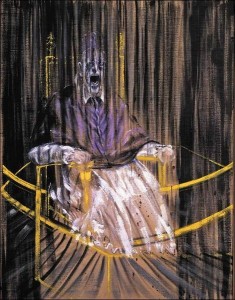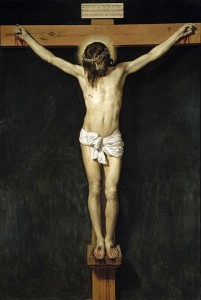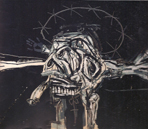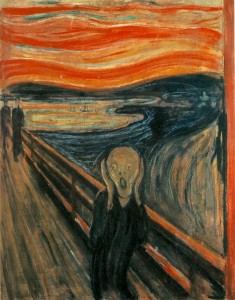By Peter Corney
 Summary: Artists, writers, film makers and playwrights in the 20th C often reflected in their work a sense of alienation, of being alone in a hostile and dystopian world. There was a feeling of bleakness about the present and frequently an apocalyptic vision of the future like Orwell’s “1984”. Other examples are Colin Wilson’s “The Outsider”, Graham Greens fascinating but sad explorations of the dysfunctional interior worlds of his anti hero’s like the man in “A Burnt Out Case”. James Dean played to perfection the iconic outsider in the film “Rebel without a cause.” The existentialists like Camus explored the possibilities of finding meaning in decision and heroic moral action but, as in his novel “The Plague”, in the end it all seemed pointless, the plague won. Francis Bacon’s paintings of a screaming Pope captured in disturbing images the angst of his contemporaries. Samuel Beckett’s play “Waiting for Godot” summed up the feeling of the times: we are alone in an unfriendly world and there is no point in waiting for God to turn up again, he is dead!
Summary: Artists, writers, film makers and playwrights in the 20th C often reflected in their work a sense of alienation, of being alone in a hostile and dystopian world. There was a feeling of bleakness about the present and frequently an apocalyptic vision of the future like Orwell’s “1984”. Other examples are Colin Wilson’s “The Outsider”, Graham Greens fascinating but sad explorations of the dysfunctional interior worlds of his anti hero’s like the man in “A Burnt Out Case”. James Dean played to perfection the iconic outsider in the film “Rebel without a cause.” The existentialists like Camus explored the possibilities of finding meaning in decision and heroic moral action but, as in his novel “The Plague”, in the end it all seemed pointless, the plague won. Francis Bacon’s paintings of a screaming Pope captured in disturbing images the angst of his contemporaries. Samuel Beckett’s play “Waiting for Godot” summed up the feeling of the times: we are alone in an unfriendly world and there is no point in waiting for God to turn up again, he is dead!
The questions I raise in this essay are: has this sense of alienation continued into the 21st C, or have we become so used to the absence of God and any greater meaning and purpose to our lives that the mood has significantly changed, or are we just expressing the absence and aloneness in a different way, or have new anxieties like saving our ecosystems replaced the old ones, or has our tendency to use popular culture to distract ourselves from deeper questions accelerated as it has been made easier and more accessible by the electronic media? It seems to me that these are important questions for Christian communicators and educators.
The Scream
The 16th C Spanish artist Velazquez produced a large body of work, two of his paintings are The Crucifixion and the portrait of Pope Innocent X.


Two 20th C painters, one English, Francis Bacon, the other a fellow Spaniard, Antonio Saura were inspired by Velazquez but produced images much more disturbing than his. They are images that express and reflect the twin anxieties of their times: the loneliness of the modern self and the horror of human violence and brutality. They had lived through the Second World War, the Jewish holocaust, the nuclear destruction of Hiroshima and Nagasaki, and Stalin and Mao’s totalitarian regimes. These two regimes brutalized thousands and forced the mass starvation and death of over 40,000,000 people in the Ukraine and China, the list goes on.
Bacon’s Pope, distorted into an endless silent scream of horror and alienation, is his response to this. The author J G Ballard wrote “Empire of the Sun” the fictionalized account of his boyhood experience in China during the Japanese invasion of China and the following rise to power of the communists. He experienced at first hand the terrible suffering that resulted. In his autobiography Miracles of Life, he describes Bacons paintings in this way: Bacons paintings were screams from the abattoir, cries from the execution pits of World War 2. His deranged executives and his princes of death in their pontiffs’ robes lacked all pity and remorse. His Popes screamed because they knew there was no God. ( Bacon went further than the surrealists, assuming our complicity in the mid century’s horrors.) (1)
Interestingly Bacon himself said very little about the inner meaning of his work with the exception of this comment: We are born with a scream; we come into life with a scream, and maybe love is a mosquito net between the fear of living and the fear of death.(2) This implies that his paintings were concerned with the individual’s struggle with the pains of existence, the struggle for meaning in the midst of living with the fear of life and the fear of death. Love provides a partial solace, but its fragile and gossamer nature gives but thin and brief protection for a short time.
Artists like Bacon reveal with stark honesty the high cost of living in a reality that excludes God. Perhaps because of their sensitivity they are more willing to face and express the nihilistic implications of their loss of faith. Antonio Saura’s crucifixion series reflects the same themes.
 Saura’s crucifixion is confronting. I first saw it some years ago in an exhibition in the Victorian National Gallery called “Beyond Belief”. He painted a number of versions, the one I saw was in stark black and white. It is a very large painting and shocked me when I turned a corner in the gallery and suddenly came upon it. It captures not only the physical brutality of torture and death but the malevolence of the evil that is its cause. The figure is distorted to the point of transformation into that which caused its suffering. The violence and cruelty, the aggression and arrogance of human evil has become concentrated in the crucified figure. He has become what has afflicted him!
Saura’s crucifixion is confronting. I first saw it some years ago in an exhibition in the Victorian National Gallery called “Beyond Belief”. He painted a number of versions, the one I saw was in stark black and white. It is a very large painting and shocked me when I turned a corner in the gallery and suddenly came upon it. It captures not only the physical brutality of torture and death but the malevolence of the evil that is its cause. The figure is distorted to the point of transformation into that which caused its suffering. The violence and cruelty, the aggression and arrogance of human evil has become concentrated in the crucified figure. He has become what has afflicted him!
Saura made this comment on the painting: Through this image of the crucified, I wanted to depict my own situation of being alone in an unfriendly world that one can only react to by shrieking. On the other side of the mirror, however, I am also interested in that absurd tragedy of the man – man not God – nailed to the cross. That image……could be seen as the tragic symbol of our age.(3)
Ironically, while Saura has created a brilliant graphic description and visual explanation of substitutionary atonement, according to the comment above, he sees in the crucifixion only the symbol of the terrible suffering man has afflicted on his fellow man. For me his painting does far more. It certainly is a confronting symbol of man’s cruelty to his fellow man – our tragic dilemma. But it also powerfully reveals the meaning of Christ’s death as the NT explains it, that he bore our sin and evil, became sin for us, that we might be forgiven and reconciled with God. Only by embracing this meaning are we able to be set free from the guilt of our complicity in the tragic dilemma. Only by embracing God the Holy Spirit are we able to find an inner transformation that can overcome the heart of darkness that is in us all and find in restored relationship with God, the answer to our sense of alienation and our despair at humanities condition.

Over sixty years earlier the Norwegian artist Edvard Munch (1863 – 1944) painted his famous scream series that visually, expressed the beginning of Western culture’s sense of alienation, a feeling that was to become the constant dull ache of the twentieth century. Munch’s own life mirrored the risks as well as the spirit of his age. He was born into a deeply religious family but his mother and elder sisters died from tuberculosis, his other sister suffered from schizophrenia. This, coupled with his fathers religious fanaticism and mental instability, contributed to his loss of faith. He was also very influenced by the charismatic nihilist philosopher Hans Jaeger. In his pain Munch retreated into his art.
“The Scream” has become one of the most famous and recognizable images of the 20th C. constantly reproduced in prints. It frequently accompanies serious journalistic pieces on our contemporary angst’s and anxieties. Ironically it has even become part of the consumer clutter of our times appearing on coffee mugs, coasters and T shirts that add to the mountains of useless detritus we produce. If for a moment we were to pause and consider the absurdity of drinking a latte’ out of a mug with a picture that expresses horror at the futility and cruelties of our world, would we laugh or cry? Maybe this is a perfect Post Modern moment, full of irony and contradiction; it’s only meaning what we choose to give it!
Perhaps this is the point at which we should come to the present and consider the question: does the 20th C’s angst and sense of alienation carry over into the 21st?
My own view is that it does but in a different way. The people of today’s world are not conscious of the loss of faith because they never had it to lose. Their anxieties are prompted by secondary losses, those that grew out of the loss of faith by the previous generations, like the loss of the values which were based on the Christian faith. Parents with a vague memory of past values feel alienated from their children as if they are from another planet. The whole discussion today about values in education is a reflection of this. It is illustrated by the decision of a third of Australian parents choosing, at significant cost, to send their children to private faith based schools. In most cases the faith issue is secondary, what parents want is a more disciplined education and what they vaguely perceive to be ‘good values!’ There is also a general woolly concern about whether we have removed or relaxed too many moral fences. If they knew it, many parents would quote G. K Chesterton when he said “Before you remove the fences ask why they were first erected!”
There is a general uneasiness about the loss of cultural unity and identity, an anxiety about what is an Australian or French or English or Indian identity now. Multiculturalism, large scale immigration both legal and illegal from cultures with a vastly different world view are raising the old xenophobic fears. The so called ‘clash of civilizations’, international terrorism, and uncontrolled people movement are creating significant anxiety and one that people feel they can not express publicly.
The British film “The Children of Men” picks up this theme with its bleak apocalyptic scenario of a Britain that is virtually an armed fortress against the avalanche of refugees from a Europe that has descended into chaos. A sign daubed on a wall reads- the future is a thing of the past. The South African film “District 9”, that describes the arrival of aliens in Johannesburg also picks up this theme and also raises the issue of the contradictory nature of humans. The treatment of the aliens by the Africans is a fascinating parable of a repetition of apartheid by the very people who fought to free themselves from the first apartheid. The same issue is being played out in real time now in Palestine. The scream of frustration at our inhumanity and stupidity goes on!
There is also a deep unconscious dissatisfaction created by consumerism. The media marketing monster, inextricably entwined with popular culture, creates a constant desire for new acquisitions, something better than what we have now. But when we get it we are still not satisfied. This breeds an underlying angst and dissatisfaction, a feeling that we are constantly being conned. TV shows like Australian Idol have now created a fantasy world that claims to make any one a star or celebrity.
In the disturbing film “Fight Club” * the writer puts these words into the mouth of Jack, one of the disillusioned young men trying to find some reality and authenticity in their empty consumer lifestyle through the violence and pain of the Fight Club. The idea is that only in this extreme experience can one feel really alive. We are the middle children of history – no purpose or place. There is no great war for us to fight, no great depression. Our great war is a spiritual war. Our great depression is our lives. We’ve all been raised on Television to believe that one day we’ll all be millionaires, and movie god’s and rock stars. But we won’t. We’re slowly learning that fact. And we’re very, very pissed off.
Disillusionment can lead to depression, anger and violence, either directed inward to ones self or outward to others. It can lead to self medication through drugs or alcohol to relieve the pain or fill the vacuum. This may be one of the reasons why currently we have such an epidemic of drug and alcohol abuse and violence among young men. “American Beauty”* taps into this same theme of despair and middle class angst at the superficiality and ephemeral nature of the consumer culture where the wrapper seems to have become the reality.
Quinton Tarantino’s films like “Pulp Fiction”*, “Kill Bill”, and “Inglourious Basterds” are intriguing but unsettling with their violence and postmodern, non linear story lines. Their references to other films point to the incestuous and self referential nature of the media. Is our ‘reality’ just a construction of the media like “the Truman Show?” Their ironic and dark humor reflects a feeling of the absurdity of our world and its absence of any meaning or truth foundation. These are artistic deconstructions of what we think is reality. To gauge the artistic world’s reaction we only need to note that Tarantino’s films have won almost every prestigious award: The Academy, the Golden globe, the Palm d’Or and the BAFTA. (Even the ironic ‘Scream’ Award in 2007!) Like the earlier cult classic “Blade Runner” (1982) “Pulp Fiction” continues the Post Modern theme with new energy.
Another reflection of contemporary anxiety is the fear of Technology overwhelming us or blurring reality and virtual reality so we are confused about what is really real. This comes through in a number of recent films like “The Matrix”, “The Sixth Sense”, “The thirteenth floor”, “eXistenz”, “The usual suspects” and “Inception”.
These examples show that the artistic production of dystopian prophecies and apocalyptic visions, and cries against man’s inhumanity and screams of despair are still very much with us in the 21st C., but they have a new edge, a new factor. We have moved from the loss of faith and angst of modernity to the confusion of post modernity. Not only does God not exist but there are no other foundations or objective truths and realities either.
My interpretation may be quite off the mark and it may be that the children of the 21st C are simply indifferent, that the scream has been replaced by “whatever!” It is certainly true that by far the most viewed media today is computer games* and the most watched conventional films are fantasy like “Lord of the Rings” and “Harry Potter”! Perhaps as Neil Postman said of the 20th C post TV generation we are still just amusing ourselves to death.
(* The computer warfare game “Call of Duty- Modern warfare 2” released in 2009 grossed a record $591 million in the first five days!)
How should we respond?
Quoting Camus or Orwell may not connect us to the cry of the 21st generation but exploring contemporary art and film may, particularly film. We need to remember that film, and electronic media is the principle way in which this generation receives its cultural and artistic expression. Once we have raised people’s awareness to what they are feeling and responding to, in a film like “American Beauty”, and identify what is being expressed, we have gained real insight and personal identification with their need or loss and so have achieved an experiential starting point for connecting them with the Gospel. This generation, unlike the previous may not know what they have lost but the vacuum, the absence is there, the longing is there. We will have to now work back from the ‘secondary losses they are aware of to the primary loss.
In response to the reaction of some people to the suffering and apparent futility of our world, Richard Holloway wrote:
The person who gives up belief in God because it brings with it certain unresolvable dilemmas ends up believing in a dying universe in which there is no meaning anywhere, a universe that came from nothing and goes to nothing, a universe cruelly indifferent to all our needs. And there is no point in feeling resentment against such a universe, because in a godless universe there is no one to resent, no one to blame. We are alone in an empty universe. No one is listening to our curses or our tears. We stand, tiny and solitary, in a corner of a vast and empty landscape, and if we listen , all we hear is the bitter echo of our own loneliness.(4)
All who mutter quietly or those who lift up there voices to scream their how’ll of despair at the world and life should ponder this statement. This is the real stark alternative to rejecting belief in God, or the absence of belief in the living God.
References:
1. J G Ballard, ‘Miracles of life’ Harper Collins 2008, p157.
2. Francis Bacon, www.artquotes.net/masters/bacon/quotes
3. A. Saura, Exhibition notes on ‘Crucifixions Exhibition’ National Museum Cracow 29-27 July 2003.
4. R. Holloway,’Paradoxes of the Christian Faith and Life’ Mowbray1984 p29.
(* I am aware that a number of these films were made at the close of the 20th C and right on the cusp of the 21st. The time frames of cultural change merge into each other.)
